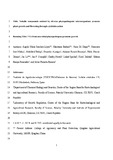Volatile compounds emitted by diverse phytopathogenic microorganisms promote plant growth and flowering through cytokinin action
Fecha
2016Autor
Versión
Acceso abierto / Sarbide irekia
Tipo
Artículo / Artikulua
Versión
Versión aceptada / Onetsi den bertsioa
Impacto
|
|
10.1111/pce.12759
Resumen
It is known that volatile emissions from some beneficial rhizosphere microorganisms promote plant growth. Here we show
that volatile compounds (VCs) emitted by phylogenetically diverse rhizosphere and non-rhizhosphere bacteria and fungi (including plant pathogens and microbes that do not normally
interact mutualistically with plants) promote growth and flowering of various plant species, includin ...
[++]
It is known that volatile emissions from some beneficial rhizosphere microorganisms promote plant growth. Here we show
that volatile compounds (VCs) emitted by phylogenetically diverse rhizosphere and non-rhizhosphere bacteria and fungi (including plant pathogens and microbes that do not normally
interact mutualistically with plants) promote growth and flowering of various plant species, including crops. In Arabidopsis plants exposed to VCs emitted by the phytopathogen Alternaria alternata, changes included enhancement of
photosynthesis and accumulation of high levels of cytokinins (CKs) and sugars. Evidence obtained using transgenic Arabidopsis plants with altered CK status show that CKs play essential roles in this phenomenon, because growth and
flowering responses to the VCs were reduced in mutants with CK-deficiency (35S:AtCKX1) or low receptor sensitivity (ahk2/3). Further, we demonstrate that the plant responses to fungal VCs are light-dependent. Transcriptomic analyses of
Arabidopsis leaves exposed to A. alternata VCs revealed changes in the expression of light- and CK-responsive genes involved in photosynthesis, growth and flowering. Notably, many
genes differentially expressed in plants treated with fungal VCs were also differentially expressed in plants exposed to VCs emitted by the plant growth promoting rhizobacterium Bacillus subtilis GB03, suggesting that plants react to microbial
VCs through highly conserved regulatory mechanisms. [--]
Materias
Cytokinin,
Flowering,
Growth promotion,
Microbial volatile compounds,
Photoregulation,
Photosynthesis,
Plant-microbe interaction,
Starch
Editor
John Wiley & Sons
Publicado en
Plant, Cell and Environment 39(12): 2592-2608 (2016)
Notas
Incluye material complementario
Departamento
Universidad Pública de Navarra/Nafarroako Unibertsitate Publikoa. IdAB. Instituto de Agrobiotecnología / Agrobioteknologiako Institutua
Versión del editor
Entidades Financiadoras
This work was partially supported by the Comisión Interministerial de Ciencia y Tecnología and Fondo Europeo de Desarrollo Regional (Spain) (grant numbers BIO2010‐18239 and BIO2013‐49125‐C2‐1‐P), the Government of Navarra (grant number IIM010491.RI1), the I‐Link0939 project from the Ministerio de Economía y Competitividad, the Ministry of Education, Youth and Sports of the Czech Republic (Grant LO1204 from the National Program of Sustainability) and Palacky University institutional support. A.M. S.‐L. and P. G.‐G. gratefully acknowledge predoctoral fellowships from the Spanish Ministry of Science and Innovation. M. B. and G. A. acknowledge post‐doctoral fellowships awarded by the Public University of Navarra.






